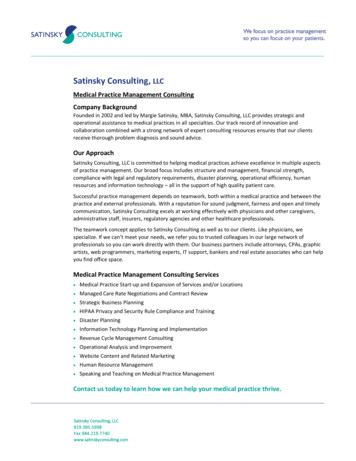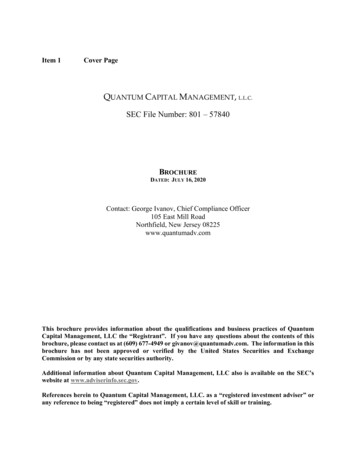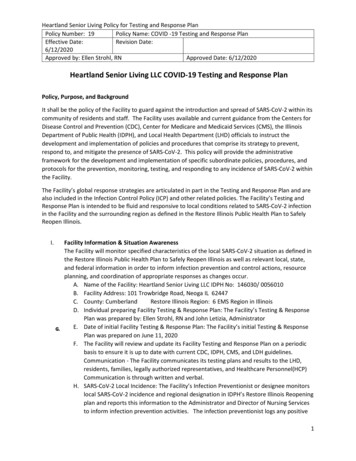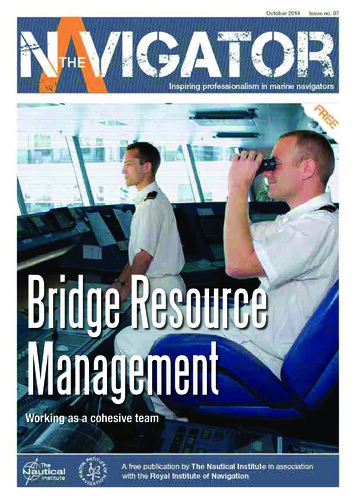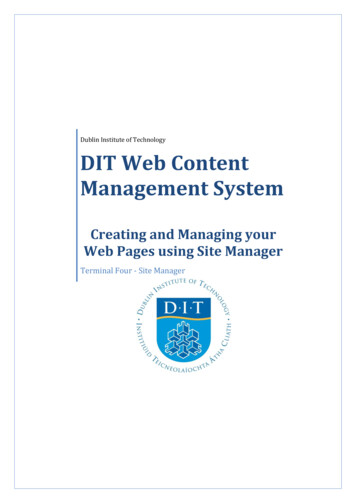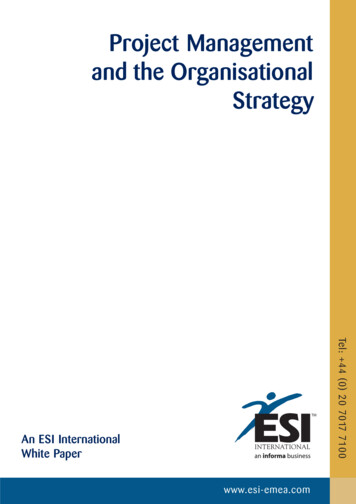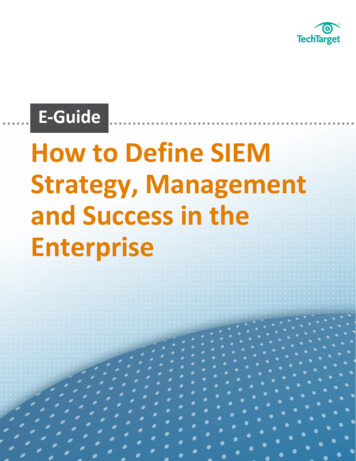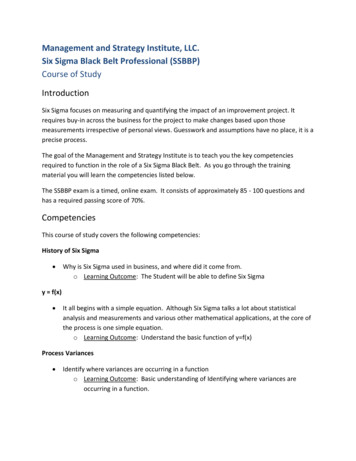
Transcription
Management and Strategy Institute, LLC.Six Sigma Black Belt Professional (SSBBP)Course of StudyIntroductionSix Sigma focuses on measuring and quantifying the impact of an improvement project. Itrequires buy-in across the business for the project to make changes based upon thosemeasurements irrespective of personal views. Guesswork and assumptions have no place, it is aprecise process.The goal of the Management and Strategy Institute is to teach you the key competenciesrequired to function in the role of a Six Sigma Black Belt. As you go through the trainingmaterial you will learn the competencies listed below.The SSBBP exam is a timed, online exam. It consists of approximately 85 - 100 questions andhas a required passing score of 70%.CompetenciesThis course of study covers the following competencies:History of Six Sigma Why is Six Sigma used in business, and where did it come from.o Learning Outcome: The Student will be able to define Six Sigmay f(x) It all begins with a simple equation. Although Six Sigma talks a lot about statisticalanalysis and measurements and various other mathematical applications, at the core ofthe process is one simple equation.o Learning Outcome: Understand the basic function of y f(x)Process Variances Identify where variances are occurring in a functiono Learning Outcome: Basic understanding of Identifying where variances areoccurring in a function.
TQM & others Discuss other process improvement methodologieso Learning Outcome: Have an understanding of the other process improvementmethodologies and how they differ from Six Sigma.Recognizing opportunities Fundamentally, the training and use of Six Sigma philosophies and principles will allowemployees and project teams to understand how systems interrelate and how to usethe application of quality improvement methodologies which complement Six Sigma,such as Lean.o Learning Outcome: Understand Six Sigma philosophies and how to recognizeopportunity.Managing Quality Quality is not about what you produce being accurate as you see it, but rather as thecustomer sees it.o Learning Outcome: Understand how to frame quality into what is important tothe customer.Deciding to start a Six Sigma project Six Sigma is a top-down methodology – that means that the decision to implementcomes from the top – whether that is the top of the business, your division of thebusiness, or some other production unit.o Learning Outcome: The student understands the "how and why" regarding acompany launching a quality improvement initiative like Six Sigma.Organizational Roles and Responsibilities How Six Sigma team are organized and understanding the role of each "belt"o Learning Outcome: Understand how team are formed and the role of each beltlevel within the Six Sigma project.The DMAIC Method Every Six Sigma project will follow the same process in a systematic and uniform methodknown as DMAIC, an acronym made up from the first letters of each element – Define,Measure, Analyze, Improve, Control.o Learning Outcome: Understand and define DMAIC
Why is DMAIC used DMAIC is a formalized problem-solving method which is designed to improve theeffectiveness and ultimate efficiency of the organization.o Learning Outcome: Understand why the DMAIC process is utilized.DMADV variation DMADV is an acronym for Define, Measure, Analyze, Design and Verify.o Learning Outcome: Understand the basis of DMADV when you do not have anexisting system or process to improve upon.Project Communication Maintaining regular communications throughout the process from the outset of theproject.o Learning Outcome: Understand why continual communication is critical to thesuccess of the project.Supporting Delivery The role of the Yellow Belt.o Learning Outcome: Understand the critical role that a Yellow Belt, or "SubjectMatter Expert" plays within the Six Sigma team.Defining a process Defining a process can be difficult at times, but it is important to determine which partsof a work task or tasks you are trying to measure.o Learning Outcome: Determine how to define a process. Process owners, scopeand boundaries.Critical to Quality Characteristics There may be several Critical to Quality characteristics for a Six Sigma project team.o Learning Outcome: Understand Critical to Quality (CTQ) measures.Cost of Poor Quality (COPQ) The Cost of Poor Quality is the sum of internal and external failures.o Learning Outcome: Understand the cost of poor quality.
Six Sigma Metrics For Six Sigma projects, the goal is to maintain statistical process control.o Learning Outcome: Understand the Sigma level, RTY, DPU, DPMO, FPY.Consequential metrics, Quality Metrics, Cost Metrics, Scheduling Metrics.Estimating the Baseline It’s important to do this to provide an accurate metric to measure the analyzed andagreed upon improvements against.o Learning Outcome: Understand the process to estimate the baseline.The Define Stage This unit provides information on the activities that would normally be expected at theinitial Define stage of a Six Sigma Project.o Learning Outcome: The Project Definition and scoping of goals and objectivesare discussed, how the process is defined in terms of stakeholders, and thefunctionalities of the process.The Measure Phase This unit provides information on the activities that would normally be expected at themeasure stage of a Six Sigma Project.o Learning Outcome: Getting more detail into the process, what metrics andmeasurements are involved as well as estimating the baseline of the current “asis” process.Six Sigma Tools This unit provides information on a number of different tools that may be usefulthroughout the many parts of the Six Sigma project.o Learning Outcome: This unit has a slightly different look than others in that itdoes not necessarily flow from one page to the next but is a series of factuallypresented pieces of information.The Analyze Phase This unit provides information on the activities that would normally be expected at theAnalyze stage of a Six Sigma project.o Learning Outcome: The value stream proposition and analysis are examined aswell as determination of the factors that influence the process output.
The Improve Stage This unit provides information on the activities that would normally be expected at theImprove stage of a Six Sigma project.o Learning Outcome: The new process is defined, potential benefits examined andverification of the new process determined.The Control Stage This unit provides information on the activities that would normally be expected at thefinal control stage of a Six Sigma project.o Learning Outcome: We discuss the standardization of new practice, verifying theimpacts /savings, and how to document lessons learned.Valuing Six Sigma This unit concludes the overview understanding to the level of a Six Sigma Green Belt.o Learning Outcome: The unit covers some more detail about the role, likeactivities of a Green Belt and how that differs from a Black Belt. It also covers thecommunications project task that a Green Belt will likely be asked to undertake.What is Lean Throughout this course, we have made several references to Lean tools, Lean processes,and how Six Sigma has borrowed from Lean. But, what is lean?o Learning Outcome: Learn the history of Lean and how it is used in conjunctionwith Six Sigma. You will also learn about lean tools such as 5S, Kaiban,TIMWOOD, 5 Why, 7S, and others.Selecting Lean Six Sigma Projects This unit looks at selecting Six Sigma Lean projects, how to build the project charter, andhow to build the necessary business case.o Learning Outcome: Learn to create a project charter and build the business case.Six Sigma Statistics This unit goes through the statistical knowledge required for Six Sigma Projects as wellas how to use them most effectively. There is also some discussion around softwareusage in Six Sigma.o Learning Outcome: Gain an understanding of Six Sigma Statistics.
Measurement Systems Analysis This unit explains when to use a Measurement Systems Analysis when the apparentvariation of a process is caused by variations in the measuring system.o Learning Outcome: Have a basic understanding of Measurement SystemsAnalysis. This includes Gage R&R, Bias Linearity, & Stability.Process Capability This unit explains process capability. Process Capability Studies are used to determinewhether a process is capable of consistently achieving specifications using systemdesign, parameter design, and tolerances.o Learning Outcome: Have a basic understanding of process capability. Systemdesign, Parameter design, and tolerances.Inferential Statistics This unit provides information on statistical theories which involve inference.o Learning Outcome: Have a basic understanding of statistical theories whichinvolve inference.Hypothesis Testing This unit provides information on hypothesis testing to see if a potential solution willwork.o Learning Outcome: Have a basic understanding of Hypothesis Testing.Simple Linear and Multiple Regression Analysis This unit provides information on performing regression analysis.o Learning Outcome: Have a basic understanding of regression analysis.Designed Experiments This unit will show the design of experiments and factorial experiments to determinethe x and y variables that affect a response.o Learning Outcome: Have a basic understanding of design of experiments andfactorial experiments.Statistical Process Control This unit describes control tools and statistical process control tool usage.o Learning Outcome: Have a basic understanding of design of control tools andstatistical process control tool usage.
Leading Six Sigma Teams This unit goes through the very basic principles of project management, project teams,and the role of the Black Belt leading the team. It also looks at the communications ofthe project leader and Black Belt.o Learning Outcome: Have an understanding of Project Management and the roleit plays in Six Sigma for a Black Belt.Ending Six Sigma Projects This unit provides information on how and when to end a Six Sigma project, how tomonitor benefits, and the responsibilities being passed on to the business.o Learning Outcome: Understand when and how to end a Six Sigma project.Making the Change This unit gives an overview of change management within the context of Six Sigmaprojects, how to assess the organizational culture, and how to gain buy in from thoseexperiencing the change.o Learning Outcome: Understand change management principles. Understandthe Black Belt role in facilitating change.
Learning ResourcesRecommended:Material included with your purchase is required reading. Free online training material provided by MSI. The material includes everything you willneed to learn to pass the exam. This material is included for free with the purchase ofyour exam. It is in digital form, and available immediately after payment.Optional:This material is not required, however it will assist you in becoming a Six Sigma Professional. The Black Belt Core Concepts Guide, available exclusively through The Management andStrategy Institute: Order HereT.M. Kubiak and Donald W. Benbow (2009) The Certified Six Sigma Black Belt Handbook,Second Edition, ISBN-13: 978-0873897327McGraw-Hill; 1 edition (2004) The Six Sigma Black Belt Handbook (Six SIGMAOperational Methods), ISBN-13: 978-0071443296Preparing for SuccessIn order to successfully complete the SSBBP exam, you will need to make sure you have theappropriate resources to support your learning. A quiet location, free from distraction.Internet access.Current (newest) version of Internet Explorer, Firefox, or Chrome browser.Take study notes while going through the training.When you are ready to take the exam, you should allot 3-hours of time.VA BenefitsThe Six Sigma Black Belt Professional (SSBBP) certification qualified for VA benefitreimbursement for qualified Veterans. Students pay for the program upfront and are thenreimbursed for the full amount of the program (up to 299.95) by the VA upon successfulpassing of the certification exam. MSI will provide you with the appropriate forms to submit tothe VA upon completion of the certification.It is the student’s responsibility to verify that they qualify for VA benefits before enrolling in theprogram. To find out if you are eligible to receive VA benefits, please contact the VA atbenefits.va.gov/gibill/
Frequently Asked QuestionsWhat happens if I fail the exam? You are given two additional attempts to pass the exam at no additional cost.Will I receive Professional Competency Units (PCU's)? Yes, the Six Sigma Black Belt Professional (SSBBP) exam awards 30 PCU's upon passing ofthe exam.
Six Sigma Black Belt Professional (SSBBP) Course of Study Introduction Six Sigma focuses on measuring and quantifying the impact of an improvement project. It requires buy-in across the business for the project to make changes based upon those measurements irrespective of personal views. Guesswork and assumptions have no place, it is a precise process. The goal of the Management and


